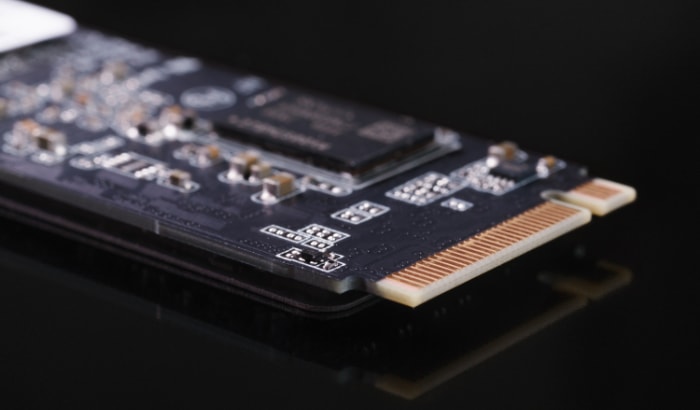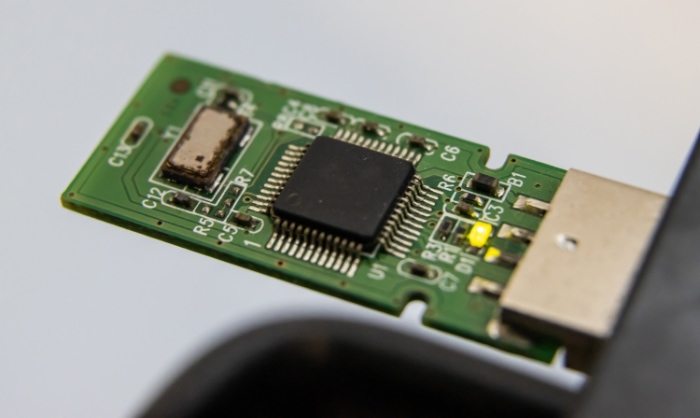Flash Storage vs. SSD: Comparing Portability and Power

The digital age thrives on rapid access to information, making the performance of storage solutions a critical factor in technology selection. Among the plethora of terms and products in the data storage market, flash storage and Solid State Drives (SSDs) are frequently discussed, often with a cloud of confusion surrounding their differences and respective advantages.
Defining the Technologies
Storage technology has evolved dramatically from the mechanical drives of yesteryears to the solid-state solutions of today. At the forefront of this revolution are flash storage and Solid State Drives (SSDs), each representing a significant leap over their predecessors.
While they share some similarities, principally their reliance on solid-state memory, their distinct definitions, and operational nuances set them apart in the storage hierarchy.
Flash Storage Explained
Flash storage is a type of non-volatile memory that can be electronically erased and reprogrammed. It's a technology that’s commonly embedded in a multitude of devices, from portable USB drives to advanced smartphones.
Definition and Functionality
Flash storage encompasses a broad array of devices and systems, essentially referring to any storage mechanism that utilizes flash memory. Its main appeal lies in its ability to retain data without the need for a power supply, coupled with its resistance to physical shock.
Types of Flash Memory
There are two primary types of flash memory used today:
- NAND Flash Memory – Known for its high capacity and durability, NAND flash is used in SSDs, memory cards, and USB flash drives, favoring write-intensive scenarios.
- NOR Flash Memory – While not as common as NAND, NOR flash memory offers faster read capabilities, making it suitable for code storage in devices like embedded systems.
Solid State Drive (SSD) Overview
An SSD is a larger and more complex storage device compared to basic flash storage. It utilizes flash memory but is designed to replace traditional mechanical hard disk drives (HDDs).
Distinct Features Compared to HDDs
SSDs eschew moving parts entirely, relying on flash memory chips for data storage. This grants SSDs their renowned speed and reliability, offering a stark contrast to the spinning disks of HDDs.
Flash Memory within SSDs
While all SSDs use flash memory, they are not synonymous with flash storage. SSDs combine flash memory with other components, such as controllers and capacitors, creating a complete storage system designed to fit into the same slots traditionally occupied by HDDs.
Performance Characteristics
The essence of any storage technology lies in its performance, which directly influences the efficiency of data management and retrieval. Evaluating the performance of flash storage and SSDs involves looking at several key factors, from speed to durability.
These attributes not only dictate the suitability of each storage type for specific applications but also their overall value proposition in an increasingly data-driven world.
Speed
The pace at which data can be written and read is a primary measure of performance for any storage solution.
Read/Write Speeds
Flash storage devices generally offer swift access to data, with speeds that far exceed traditional magnetic storage options. However, SSDs take speed to a new level, often boasting faster read and write speeds thanks to their advanced controllers and parallelism in chip architecture.
This makes SSDs particularly effective for tasks that require quick access to large files or databases.
User Experience Impact
For end-users, the superior speed of SSDs translates into shorter boot times, quicker file transfers, and smoother application performance. The immediacy with which an SSD can serve data can significantly enhance the user's interaction with the device.
Durability
The toughness of a storage medium is as critical as its performance, especially in mobile devices and in scenarios where data security is paramount.
Shock Resistance
Both flash storage and SSDs offer robust durability, with no moving parts to wear out or fail upon impact. This solid-state nature provides a level of assurance against data loss from physical damage.
Longevity and Reliability
Flash storage and SSDs differ in their approach to managing the finite number of write cycles each cell can handle. SSDs typically include more sophisticated wear-leveling algorithms and additional spare cells to extend the drive’s viable life.
Data Integrity and Retention
Maintaining data accuracy and preventing loss over time are challenges that storage technologies must overcome.
Data Management Over Time
Flash storage provides stable data retention, making it suitable for devices where data is not frequently changed, such as digital cameras. SSDs, often employed in dynamic environments like computers, are built with error-correcting code (ECC) and bad block management to ensure the integrity of the data over extensive read/write operations.
Wear Leveling and Error Correction
Wear leveling is a technique used in SSDs to distribute write and erase cycles across the memory cells evenly, thereby prolonging the life of the device. Coupled with ECC, this ensures that SSDs not only last longer but also maintain data integrity throughout their use.
Storage Architecture and Design

The architecture and design of storage devices are as important as their performance, dictating not only the potential uses for the technology but also its adaptability and scalability. The physical form, combined with the storage capacity and the sophistication of the controller technology, play crucial roles in how flash storage and SSDs are integrated into larger systems and daily usage.
Form Factors
The physical configuration of a storage device has direct implications for its versatility and compatibility with different types of hardware.
Variety in Physical Designs
Flash storage comes in an array of form factors, each tailored to specific devices or uses, such as microSD cards for mobile devices or compact flash for high-end photography. SSDs, while initially conforming to the 2.5-inch form factor to fit into spaces for traditional hard drives, have evolved. Now, they are also available in smaller, more versatile configurations like the mSATA and M.2, which are common in laptops and ultrabooks for their compact size.
Compatibility and Use Cases
The choice of form factor can be driven by the need for portability, as in USB thumb drives, or the necessity for higher performance and capacity in enterprise server arrays. SSDs, due to their varied sizes, can be used in a broader range of devices, from desktops to data centers, offering high performance in each context.
Capacity
The amount of data that can be stored in a device is a primary consideration for any user or organization.
Trends in Storage Capacity
As technology advances, the capacity of both flash storage and SSDs has seen an upward trajectory. Flash storage devices, such as SD cards, now commonly reach capacities that were once the domain of SSDs, allowing for extensive storage in even the smallest devices.
Storage Size Selection
When choosing between flash storage and an SSD, one must consider not only the current capacity needs but also future requirements. SSDs offer larger capacities, suitable for operating systems and applications, while flash storage is typically used for secondary storage purposes.
Controller Technology
The controller is the unsung hero of storage devices, managing the interaction between the storage medium and the device's CPU.
Role of Storage Controllers
Controllers dictate the speed and efficiency of data transfer. In SSDs, they are particularly sophisticated, offering features like wear leveling, bad block management, and error correction, which contribute to the device's overall performance and longevity.
Influence on Performance and Reliability
The advanced controller technology in SSDs can dramatically influence not just the speed but also the reliability of the device. Flash storage, with its simpler controller designs, is better suited for less demanding applications where the paramount requirement is often simply the ability to store data reliably over time without active management.
Use Cases and Suitability
Each storage technology excels in different environments, influenced by its inherent capabilities and limitations. From personal gadgets to enterprise servers, the choice between flash storage and SSDs hinges on the specific needs of the application at hand.
Identifying the optimal use case for each technology allows users and enterprises to leverage their strengths and avoid potential pitfalls.
Flash Storage Applications
Mobile and Embedded Systems
Flash storage is commonly found in mobile phones, digital cameras, and other portable devices where space is at a premium and power efficiency is crucial. Its small form factor and low power consumption make it ideal for these uses.
Boot Drives and ReadyBoost
In computing, flash storage is often used as a boot drive for operating systems in embedded systems or as a cache component via technologies like ReadyBoost on Windows, which uses flash memory to improve system speed without adding more RAM.
SSDs in Computing and Enterprise
Primary Drives in Computing
In laptops and desktops, SSDs serve as the primary storage medium due to their high speed and reliability. They are preferred for hosting operating systems and applications, providing a responsive computing experience.
Data Centers and High-End Workstations
The high transfer speeds and robustness of SSDs make them a staple in servers and workstations that handle large databases, intensive applications, or complex computational tasks. They are also increasingly used in data centers for cloud storage solutions, where their speed and efficiency support a high volume of data transactions.
Suitability Based on Durability and Performance
Portable Storage and Durability Needs
Flash storage devices, such as USB drives and SD cards, are suitable for transferring data between devices and for their ability to withstand rough handling, making them reliable for portable storage.
Performance-Intensive Environments
SSDs shine in environments where performance is a priority. This includes gaming, high-definition video editing, and real-time data analytics, where their fast read/write capabilities can be fully utilized.
Selecting the Right Storage for Your Needs
The choice between flash storage and SSDs ultimately depends on the user's specific requirements. For those who need compact, mobile storage that retains data without power, flash storage is the go-to option.
Conversely, for users seeking high-performance storage for their computing devices, SSDs offer a significant advantage in speed and capacity, albeit typically at a higher cost point.
Cost Considerations

When investing in storage solutions, cost plays a decisive role alongside performance and durability. The economic aspect encompasses not only the initial purchase price but also the long-term value, which includes factors such as the lifespan of the device and maintenance costs.
Assessing these costs requires a nuanced understanding of how flash storage and SSDs fit into the broader financial framework of personal and enterprise budgets.
Initial Purchase Price
Price per Gigabyte
The cost of flash storage and SSDs can be significantly different when measured in terms of price per gigabyte. Flash storage devices like USB flash drives and SD cards typically offer a lower cost per gigabyte, making them economical choices for casual use or when moderate amounts of storage are sufficient.
SSDs and Premium Pricing
SSDs generally command a higher price per gigabyte compared to flash storage due to their higher performance, greater durability, and larger capacities. The advanced technology and longevity built into SSDs often justify their premium pricing, particularly in professional or enterprise environments.
Long-Term Value and Total Cost of Ownership
Depreciation Over Time
As with any technology, storage devices depreciate over time. Flash storage devices, which are often used in less demanding environments, may have a longer functional lifespan in their intended use case, potentially offering a better cost-benefit ratio over many years of use.
Maintenance and Replacement Costs
The absence of moving parts in both flash storage and SSDs translates to minimal maintenance costs. However, SSDs have a more sophisticated design and higher endurance, which can lead to a lower total cost of ownership for users who require a high-performance storage solution that can handle intense read/write cycles.
Cost Impact of Performance and Capacity
Performance as a Cost Factor
In professional settings where time is a critical factor, the superior speed of SSDs can lead to cost savings by enabling faster data processing and reduced downtime, offsetting the higher initial expense.
Balancing Capacity and Expense
For users who need substantial storage capacity, SSDs can offer more space within a single device, potentially reducing the need to purchase multiple units. While this comes at a higher upfront cost, it may result in savings in physical space and power consumption.
The Economy of Scale
Market Trends and Production Costs
The prices for both flash storage and SSDs have been falling due to economies of scale and technological advancements. As demand for storage continues to grow and production processes become more efficient, the cost differential between flash storage and SSDs is likely to continue to narrow, making high-capacity, high-speed storage solutions more accessible to a wider range of users.
Conclusion
Reflecting on the comparative analysis of flash storage and SSDs, it is clear that each has its own realm of excellence tailored to specific needs and environments. Flash storage stands out for its portability and cost-effectiveness, making it a suitable choice for mobile devices and light storage requirements.
SSDs, on the other hand, offer superior performance and durability, positioning them as the preferred option for intensive computing tasks and long-term scalability in both personal and enterprise contexts. The ongoing advancements in technology and manufacturing promise to further enhance the capabilities and reduce the costs of these storage solutions, ensuring that both flash storage and SSDs will continue to play critical roles in data storage and management strategies.
This comprehensive overview highlights the importance of evaluating both technologies not as competitors but as complementary components of a robust digital infrastructure.


